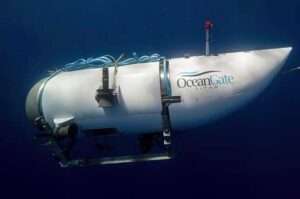
The Transportation Safety Board of Canada has opened an investigation into the implosion of the Titan, the underwater sea vessel that imploded with five people onboard as it was traveling to the wreckage of the Titanic, the British ocean liner that sank in the North Atlantic in 1912 after striking an iceberg.
The submersible vessel was the property of OceanGate Expeditions, a U.S.-based company. Its support ship, Polar Prince, however, is a Canadian-flagged ship.
“The Transportation Safety Board of Canada (TSB) is launching an investigation into the fatal occurrence involving the Canadian-flagged vessel Polar Prince and the privately operated submersible Titan,” the board said in a statement Friday, raising questions about the safety of the ill-fated excursion. The board said a team of investigators has been sent to St. John’s, Newfoundland, to gather information and conduct interviews.
U.S. officials said they too, were opening an investigation.
“The U.S. Coast Guard has declared the loss of the Titan submersible to be a major marine casualty and will lead the investigation. The NTSB has joined the investigation and will contribute to their efforts. The USCG is handling all media inquiries related to this investigation,” the U.S. National Transportation Safety Board said Friday in a tweet.
The Polar Prince lost contact with the Titan an hour and 45 minutes after the submersible began its descent Sunday.
Responders rushed equipment to where remains of the Titan were found. Five major fragments of the 6.7-meter Titan were located in the debris field left from its disintegration, including the vessel’s tail cone and two sections of the pressure hull, U.S. Coast Guard officials said. No mention was made of whether human remains were sighted.
OceanGate Expeditions said in a statement the five people on the vessel were company CEO Stockton Rush, Shahzada Dawood and his son Suleman Dawood, Hamish Harding, and Paul-Henri Nargeolet.
Since the submersible went missing with an approximately four-day air supply, questions about it its safety have grown.
“I know there are also a lot of questions about how, why and when did this happen,” said Rear Adm. John Mauger of the First Coast Guard District. “Those are questions we will collect as much information as we can about now.”
According to an Associated Press report, David Lochridge, a former OceanGate director of marine operations, raised questions in 2018 about the methods the company used to insure the structural viability of the hull.
Filmmaker James Cameron, who directed the 1997 Academy Award-winning film Titanic and who has made several dives to the ocean liner’s wreckage aboard other deep-sea submersibles, said in an interview with the BBC that he was sure an “extreme catastrophic event” had happened when he heard the submersible had lost communication and navigation.
“For me, there was no doubt,” he said.
He told the BBC the news about the air supply and underwater noises were a “prolonged and nightmarish charade” to provide false hope to the families of the passengers. Cameron said that once a remotely operated vehicle reached the depth of the vessel, it was likely to be found “within hours … probably within minutes.”
Arthur Loibl, a passenger on the Titan two years ago, described his trip to the Titanic as a “kamikaze operation.” The retired German businessman said, “Imagine a metal tube a few meters long with a sheet of metal for a floor. You can’t stand. You can’t kneel. Everyone is sitting close to or on top of each other.”
Scientist and journalist Michael Guillen, who survived an expedition in 2000 that ran into some challenges, said, “We need to stop, pause and ask this question, why do you want to go to the Titanic and how do you get there safely?”
Some information is from The Associated Press and Reuters.
[content id=”52927″][content id=”79272″]




